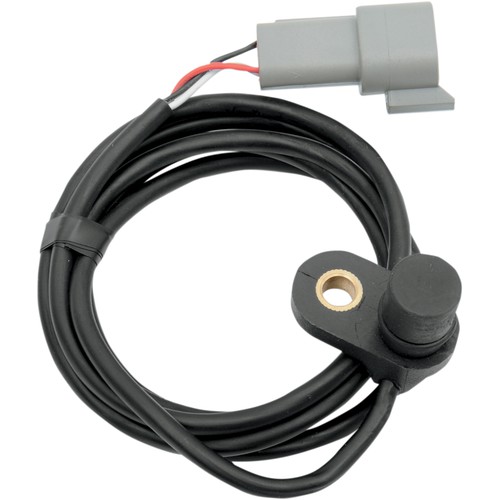Step by Step Instructions for Testing Your Harley’s Charging System
1. Battery Test:The battery needs to be a fully charged battery that has been load tested to ensure proper readings. If you are not working with a fully charged and functional battery, all other voltage tests will be incorrect. Most places like Auto Zone, Advance Auto, and Pep Boys will charge and test motorcycle batteries for free. Standing battery Voltage should be 12.5-13.2 DCV.
2. Charging System Voltage Test: Start motorcycle, Measure DC Volts across the battery terminals (you should have a reading of approximately 13.2-15 DC Volts).
3. Check Connections/Wires: Inspect the regulator/stator plug, and check the battery terminals for connection/corrosion. If everything seems to be in order, move on to number 4 below to determine if there’s a failed component.
4. Stator Checks/Rotor Check: Each of the following tests isolate the stator & Rotor, If AC Output test Fails and Resistance Check, and Stator IB Test Pass then Rotor is at fault (Pull Primary covers and inspect rotor for damage).
- Unplug the regulator plug from the stator
- Start motorcycle and change Voltmeter to AC volts.
- Probe both stator wires with your meter leads.
- The motorcycle should be putting out approximately 18-20 ACV per 1,000 rpm. (Reading will vary depending on system, check service manual specification)
- Generic Specs:
- 22 amp system produces about 19-26 VAC per 1,000 rpm
- 32 amp system produces about 16-20 VAC per 1,000 rpm
- 45 amp system produces about 19-26 VAC per 1,000 rpm
- Switch your multi meter to Ohm x 1 scale.
- Probe each stator wires with meter leads and check resistance on meter.
- Resistance should be in the range of 0.1-0.5 Ohms. (Reading will vary depending on system, check service manual for specification)
- Generic Specs:
- 22 amp system produces about 0.2 to 0.4 ohms
- 32 amp system produces about 0.1 to 0.2 ohms
- 45 amp system produces about 0.1 to 0.2 ohms
- Stator IB test or Ground Check:
- Switch your multi meter to Ohm x 1 scale.
- Probe each stator wire with your positive lead on multi meter and the negative to ground.
- There should be no continuity to ground on either wire.
- If there is continuity to ground your stator is shorted to ground.
5. Regulator Test: Each of the following tests isolates the regulator only, so if any of these tests fail, the regulator is at fault.
- Battery Charge Lead– Wire going from regulator to battery positive.
- AC output leads– Wires coming from the Stator to regulator.
- Ground– Wire from Regulator to ground or regulator may be grounded via the physical bolting to chassis.
- Regulator Ground Test: Insure the regulator body is grounded or grounding wire is fastened tight to a good ground (you should verify this by checking continuity from regulator body to chassis ground).
- Fwd/Reverse Bias Test/Diode Test: This check is testing the Diode function to ensure it is regulating the AC current for the stator into DC Current.
- Switch multi meter to Diode Scale.
- Place your Multi meter positive lead on each AC output wire.
- Place your multi meter negative lead on the battery Charge wire.
- The meter should read voltage typically around .5 volts.
- Next, switch your multi meter leads putting the negative lead on the AC output wires and the Positive lead on the Battery Charge Wire.
- The reading should be Infinite.
- With your meter on the same setting, place your multi meter positive lead on the regulator ground wire or to the regulator directly, and then place your meter negative lead on the AC output leads.
- The meter should read voltage typically around .5 volts.
- Next, switch your multi meter leads putting the negative lead on the regulator ground and the Positive lead on the AC output wires.
- The reading should be Infinite.
- Note: Below is a table to show the readings:
Positive Lead Negative Lead Reading
AC output 1 Battery charge lead Voltage
AC output 2 Battery Charge Lead Voltage
Battery charge lead AC output 1 ∞
Battery charge lead AC output 2 ∞
Ground AC output 1 Voltage
Ground AC output 2 Voltage
AC output 1 Ground ∞
AC output 2 Ground ∞
Replacement Components
Batteries
350-430 (97-09 FLT, FLH, FLHT Dressers)
350-431 (82-94 FXR, 84-90 Softail, 71-86 FX, 79-96 XL)
350-432 (91-09 Softail, 97-09 Dyna, 97-03 XL)
350-433 (80-96 FLT, FLHT, 93-96 FLHR)
Stators:
380-864 (L84-90 XL)
240-556 (91-06 XL)
381-259 (70-75 Big Twin 15 Amp)
381-084 (76-80 Big Twin17.8 Amp)
381-260 (81-88 Big Twin 22Amp)
381-202 (89-99 Big Twin 32 Amp)
381-596 (00 Softail, 99-03 Dyna)
381-594 (99-01 Touring)
381-595 (02-05 Touring)
Regulators: (Offered in Chrome and Black, Black Part numbers listed below)
380-798 (84-85 XL)
381-177 (86-90 XL)
381-014 (91 XL)
380-797 (92-93 XL)
380-485 (94-03 XL)
381-835 (04-06 XL)
383-089 (07 XL)
381-252 (70-75 Big Twin)
381-328 (76-80 Big Twin)
381-327 (81-88 Big Twin)
381-277 (89-99 Big Twin)
381-605 (00 Softail)
381-603 (97-01 Touring)
381-606 (00-03 Dyna)
Rotors:
380-373 (70-06 Big Twin 18, 22, 32 Amp Systems)
380-374 (95-06 Big Twin 38 Amp Systems)
380-375 (97-05 Big Twin 45/48 Amp Systems)
383-640 (84-90 XL)
383-641 (91-03 XL)
383-642 (04-09 XL)
Start with a Good Full Charged Battery
If in doubt replace it before tests and if you see a drop of 10 volts or less it is BAD

